Is Speed Reading a Hoax?
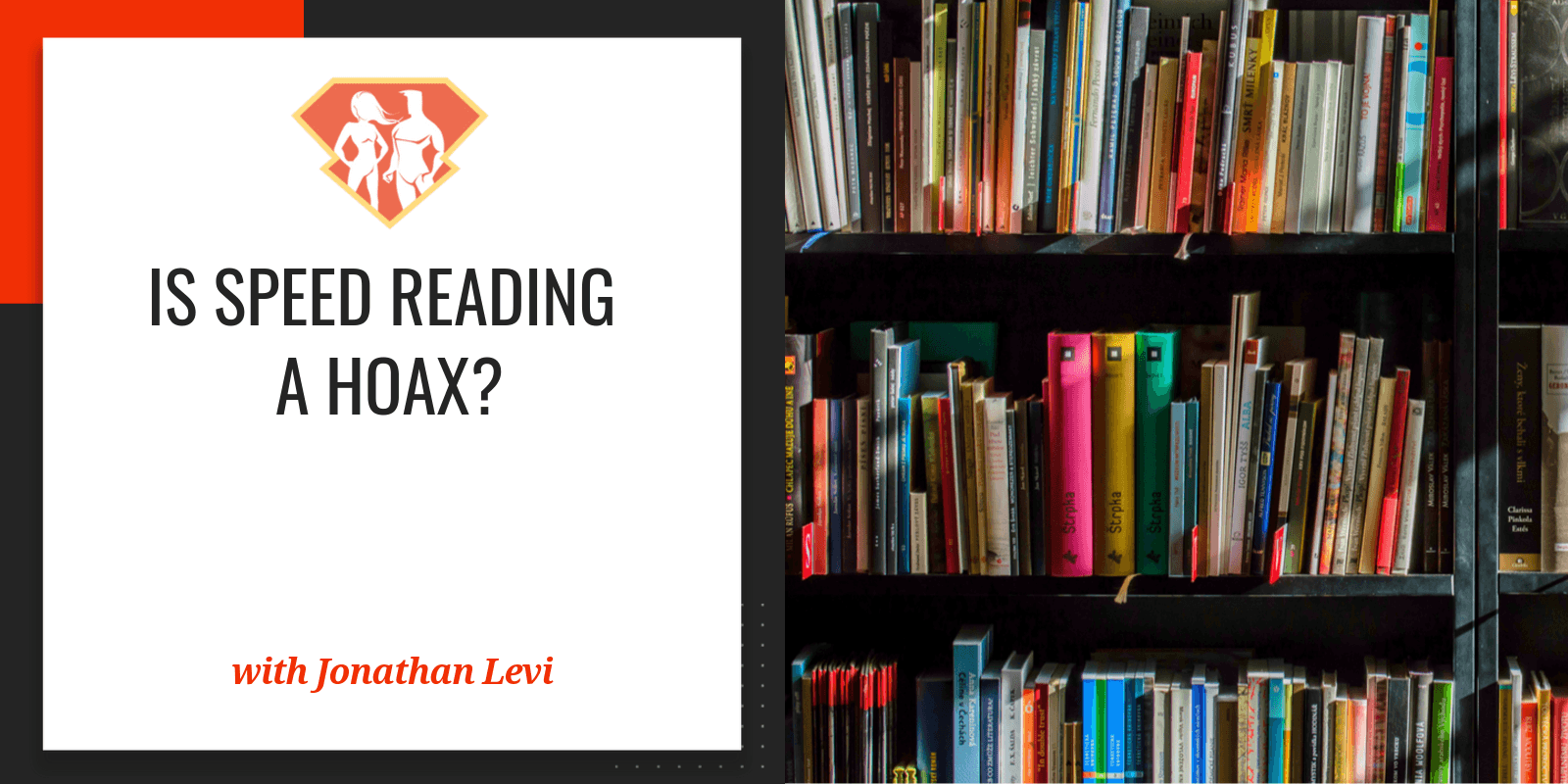
Greetings, SuperFriends!
This week we are going to dive into a rather controversial topic, one that people have brought up to me for years. That is, is speed reading a hoax, or is it the real deal?
You know, over the last few years that I've been teaching accelerated learning a lot of people have sent me many articles either proving or disproving speed reading. Therefore, what I wanted to do was sit down and look at one of the most prominent studies disproving it, which is an evaluation of many other studies, and also share some studies proving it.
Now, probably the most surprising thing through this whole exercise and analysis was that I probably agree with 70% t0 80% of what the research has found and you will see exactly why as I explain through the entire episode. You will listen to a lot of surprising things and a few surprising ones.
I encourage you guys to challenge me and my assumptions, to share what you guys think and also to think critically about what I have to say. I think you guys are really going to enjoy the episode, I think it's going to clear up a lot of misconceptions that people have around what we do, what I do, and also what the speed reading industry as a whole does.
Note: I've turned this episode into a video, too! If you prefer to watch the video version, you can do so below:
Speed reading is a pretty controversial topic. After all, in this day and age, who wouldn’t want to be able to read faster and remember more?
But in the past, the speed reading industry has been… well, a bit dodgy. A lot of big promises, and not a lot of results. Even I, as a teacher of speed reading and memory enhancement, failed with a couple of these so-called speed reading methods in my early youth, leading me to believe that it was all a bunch of bullshit.
And then, there’s the research. Every so often, a student or would-be student will post in our facebook group with the latest piece of research that supposedly proves or disproves speed reading.
Who should you believe? Is speed reading the real deal? Or is it, like psychics and UFO’s, mostly BS?
Well, to dive into this, I dove into one of the most commonly-cited research papers that “disprove” speed reading:
“So Much to Read, so Little Time: How Do We Read, and Can Speed Reading Help?”, written by Keith Rayner, Elizabeth R. Schotter, Michael E. J. Masson, Mary C. Potter, and Rebecca Treiman, psychology researchers from UC San Diego, University of Victoria, MIT, and Washington University at St. Louis.
To be clear, I want to say from the outset that this is a very impressive and well-thought out paper — 60+ pages of analysis of various studies, with 16 entire pages of citations and references. I have no intention of calling into question the legitimacy or scientific credentials of any of the researchers… on the contrary, I agree with the vast majority of what they’ve found.
In fact, I found only one major inconsistency in their work that I couldn’t agree with…
But overall, if anything, I found their paper to be a huge validation of a lot of the things that our company has been telling students for years… even if that’s not at all what the researchers intended to communicate.
How can that be, you ask?
Well, let me explain, point by point.
First off, I’d like to point out that one major inconsistency in the authors’ claims that I mentioned.
You see, on pages 11 and 12, the authors explain the properties of rods and cones in the human eye, showing diagrams of how our eyes are able to focus on a very limited area called the fovea

They then conclude:
“These facts about rods and cones have some important implications for reading. As we have discussed, all text, regardless of writing system, is comprised of combinations of lines, normally dark on a white background. Therefore, fine discrimination between dark and light areas is essential to recognizing the visual elements of writing. If the light pattern coming from a word hits the fovea, the cones will easily recognize such fine detail and relay the pattern — with high fidelity — to the brain. However, if the word hits non-foveal areas and is sensed primarily by rods, it will be relayed to the brain as an average and will appear fuzzy. This will make it difficult to discern the exact identities of the symbols (see the beginning and end of the sentence represented in Figure 2). In fact, when people are asked to report the identity of a word that is presented so briefly that they cannot make an eye movement, accuracy is high in the fovea and drops off dramatically, with performance reaching chance levels around the middle of the parafovea (approximately 3 degrees of visual angle away from fixation), Bouma, 1973;
The authors go on to state:
“These facts cast doubt on suggestions from speed reading proponents that people can read more effectively by using peripheral vision, taking in an entire line or even an entire page at a time.”
My response?
They’re absolutely right!
In contrast to a lot of the scammy “photo reading” courses out there, we would never claim that people can take in an entire line at once… much less an entire page!
So, where’s the inconsistency, then?
Well, as mentioned above, the authors claim that anything outside of the foveal area of the eye — the central focus point of the eye — words are “fuzzy and difficult to discern.”
But just a few paragraphs later, on pages 13–14, the authors provide much stronger arguments against their own claim than I could possibly hope to, when they shift their attention away from photo-reading towards debunking apps like Spritz that show you one word at a time.
In this argument, the authors claim that these apps don’t work, because they don’t allow you to see the context of the other words around the word you’re reading — even if those are words you would “skip” as a speed reader.
To quote:
“Importantly, just because a word is skipped does not mean that it was not processed at all. All major theories of reading posit that word skipping is based on at least partial recognition of the word from information obtained in parafoveal vision and/or expectations about the word’s identity…. This shows that readers are actually processing many or most of the words they skip over, along with the words they fixate…”
Here’s the part that really made me scratch my head, though:
“Although acuity is lower in the parafovea than in the fovea, information in the parafovea is not completely ignored.”
“If the word to the right of the fixated word disappears after 60 ms, reading behavior is disrupted (even if the word reappears once it is directly fixated; Rayner, Liversedge, & White, 2006). This finding suggests that readers use information from more than just the fixated word in order to read efficiently.”
Wait, what?
A few pages prior, while debunking speed reading courses, the authors claimed that anything in the parafovea –

the area outside the focus point of our view — is “fuzzy and difficult to discern.” But now, when debunking so-called speed reading apps, they are claiming that this peripheral parafovea vision is essential for reading and comprehension?
I don’t know about you guys, but that seems like a major contradiction to me.
The authors even include graphical explanations, outlining studies that proved the importance of the parafovea for effective speed reading:
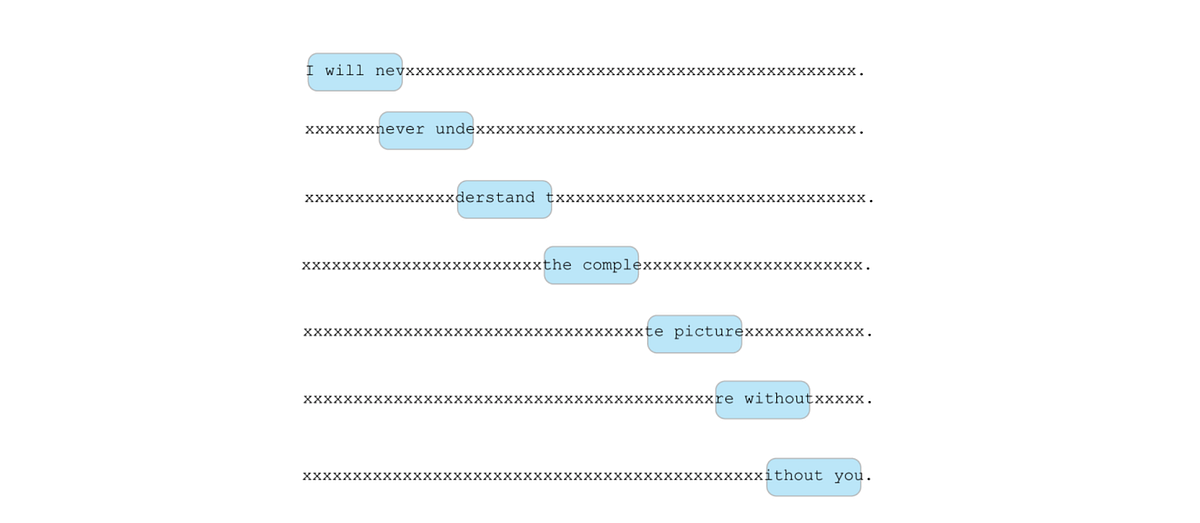
An example of the type of experiment the authors used to prove that we *do* use the parafovea for improving comprehension and previewing.
In fact, this is exactly what we’ve been claiming for years: that by using tools like Schultz tables
to train your brain and eyes to pay more attention to information in the parafovea, you will be able to increase your reading speed and comprehension.
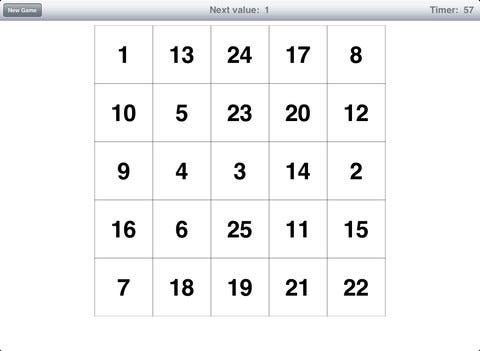
The Schultz Table, one of the most common strategies for training the mind to recognize further out into the parafovea.
You see, one of the biggest arguments made by critics of speed reading is that there’s no way the brain can comprehend as fast as speed reading teachers claim it can.
Of course, as I said before, many speed reading teachers do make outright bogus claims of thousands of words per minute, and except for a few select individuals I’ve met in the past, it’s important to stress the fact that I don’t trust 95% of those claims.
So, what do the authors have to say about it?
To quote:
“The use of foveal and parafoveal information to process text. Now that we have reviewed the characteristics of eye movements, we return to the issue of how information is obtained from a text once an eye movement is made. Visual perception occurs very rapidly — so rapidly, in fact, that even if a word disappears completely after only 60 ms of directly looking at it, reading behavior is unaffected. That is, fixation durations were similar regardless of whether the word remained visible or was erased or masked after 60 ms” (Ishida & Ikeda, 1989).
They continue:
“These findings suggest that visual perception takes up only a small fraction of fixation durations, leaving time for higher level cognitive and linguistic processing to occur before the decision of when to move the eyes next. Crucially, the finding that readers’ eyes remained on words that had disappeared for as long as they would have when the words were still there suggests that the reading system naturally delays looking directly at the next word until it has performed a certain amount of linguistic processing of the currently fixated word.”
My response?
Again, they’re absolutely right.
And we’ve been telling people this for years, too. The only difference is that we’ve been saying that you can process the visual information you took in at the end of the paragraph or even at the end of the page, if you’re creating visual mnemonic markers — rather than after every word. Like doing all of your laundry at once instead of one sock at a time, this is a method of batching the processing and comprehension — and as we’ve said from day 1 — it’s only possible by learning advanced memory techniques to overcome the limits of short term memory. But more on that later.
Next, we have another claim that I completely agree with:
“When a word falls within the perceptual span, it can be perceived but not necessarily fully identified. In fact, the area from which words can be identified, the word identification span, is much smaller than the perceptual span. The word identification span is about 7 characters to the right of fixation in English ( see Rayner, 1998). Thus, with normal text, there is a small window comprised of the currently fixated word and one or two words to the right within which words are identified. The perceptual span is a larger window, used to perceive the visual layout of the text (i.e., where the words and spaces are , in writing systems that have spaces ) in order to plan eye movements. The final aspect about the perceptual span that we should point out is that readers do not access any information from the lines above or below the line currently being read (Pollatsek, Raney, LaGasse, & Rayner, 1993) . This is important because it is inconsistent with the speed reading claim that someone can read an entire page at once.”
Why, yes! I agree!
Not just with the fact that you cannot read multiple lines at once, but also, the authors themselves make the point that our perceptual span is wider than just the word we’re reading — in fact, it includes about 7 characters to the right — i.e. another word or two.
Funny enough, that’s almost exactly the claim we make in our speed reading trainings.
By now, you might be starting to think that we had a hand in funding this research paper… haha!
But the list of vindicating findings goes on and on.
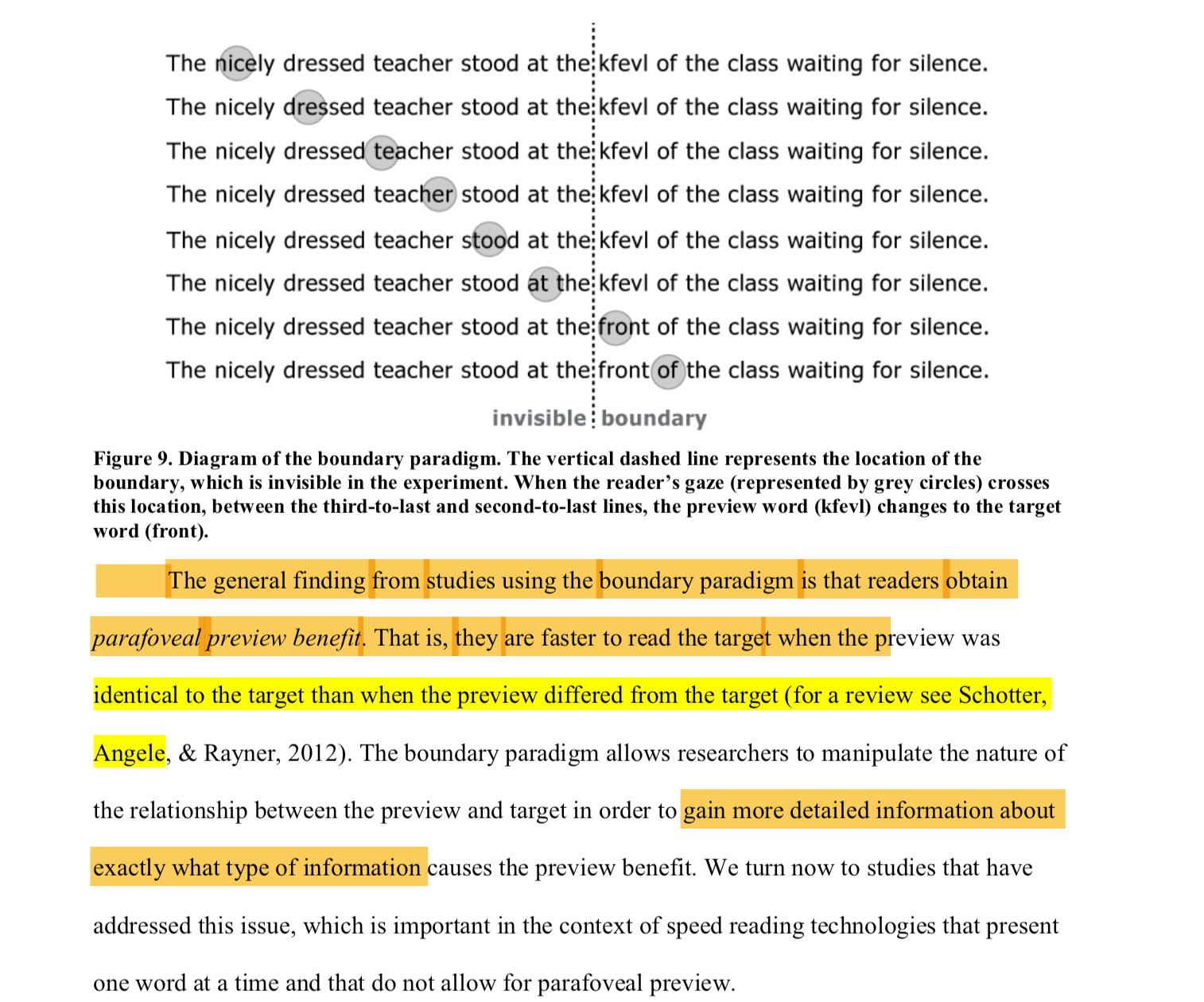
Another example of an experiment used to test if we actually use the parafovea (we do).
“The general finding from studies using the boundary paradigm is that readers obtain parafoveal preview benefit. That is, they are faster to read the target when the preview was identical to the target than when the preview differed from the target (for a review see Schotter, Angele, & Rayner, 2012)
Of course, there are some caveats. The research being cited did show that people can’t fully recognize words two to the right of the word they’re fixated on unless the words are short — and this is in line with our claims.
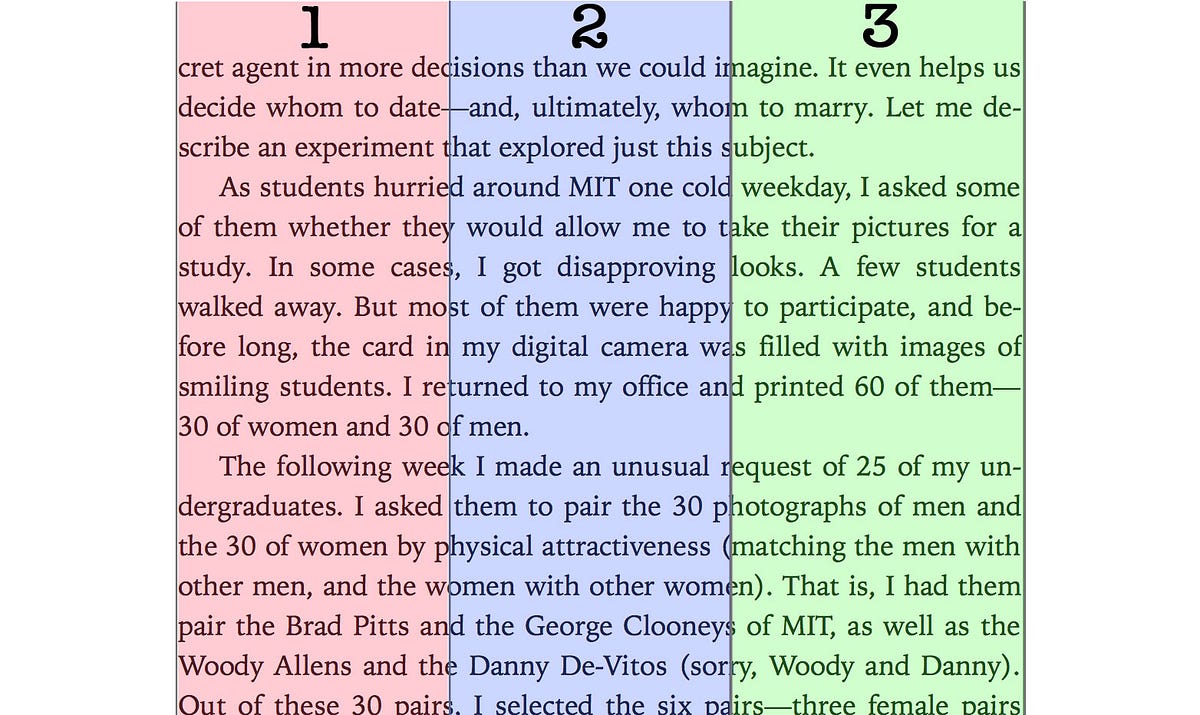
A diagram used in our speed reading course to demonstrate how to structure the movements of your eye (fixactions).
In our courses, we suggest 3 fixations on a normal page, which usually has about 8–10 words… or, in other words, that your fixations will only see a maximum of 3 or so words each!
The list of supporting evidence goes on and on…
On page 30,
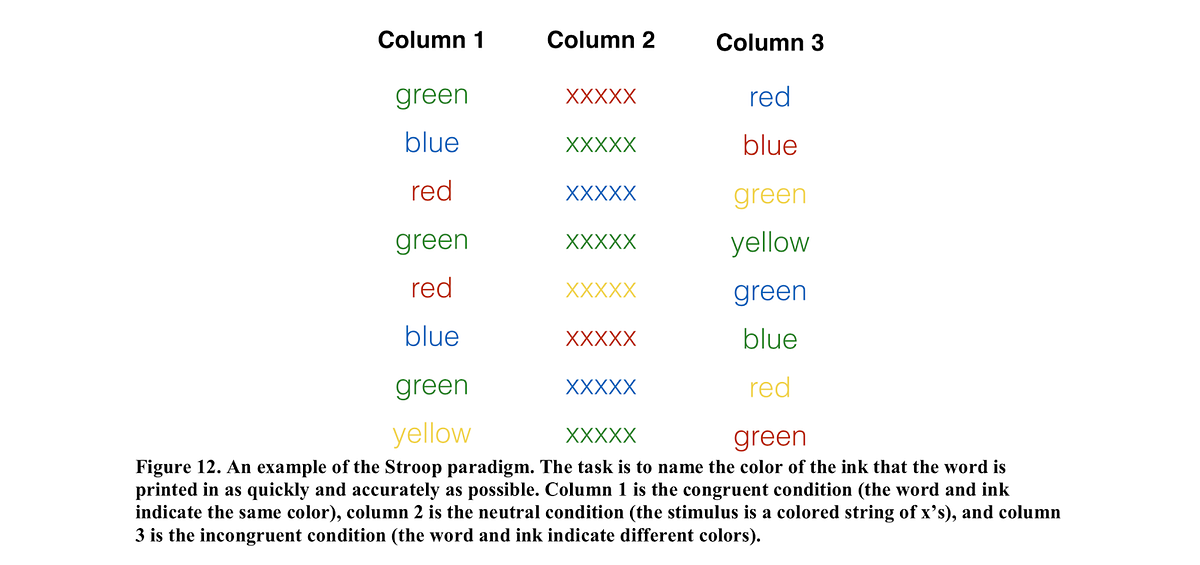
A common experiment used to demonstrate the role of subvocalization in reading.
the authors demonstrate the fact that visual word recognition is so incredibly quick and strong that it can interfere with retrieval of a competing word — the name of the color.
On Page 33, they begrudgingly admit that readers are able to comprehend even while saying nonsense words out loud to reduce subvocalization (the little voice in your head when you read), but found that for combining concepts together, they weren’t as good — which is why we advocate the pausing and reviewing concepts at the end of each page and chapter
Now, on the note of subvocalization, It’s important to note that we do NOT claim you can completely eliminate subvocalization — but rather, that it should be reduced. Our only claim is that you don’t need to read a large portion of the words in your head, and this was found to be true even in their research, which found that based on whether the word is a homophone or not, it may or may not be subvocalized.
So, I know what you’re thinking:
Wasn’t this supposed to be a research paper debunking speed reading? Where is the criticism here?
Well, on page 49, the authors debunk a lot of speed reading courses which claim you can read entire sentences or zig-zag across pages… and I agree, for all of the reasons above. The only place I would differ is that I strongly believe that people can take in small groups of words, as I explained — and the researchers’ own findings substantiated — before
As we get towards the end of the paper, on Page 50–51,
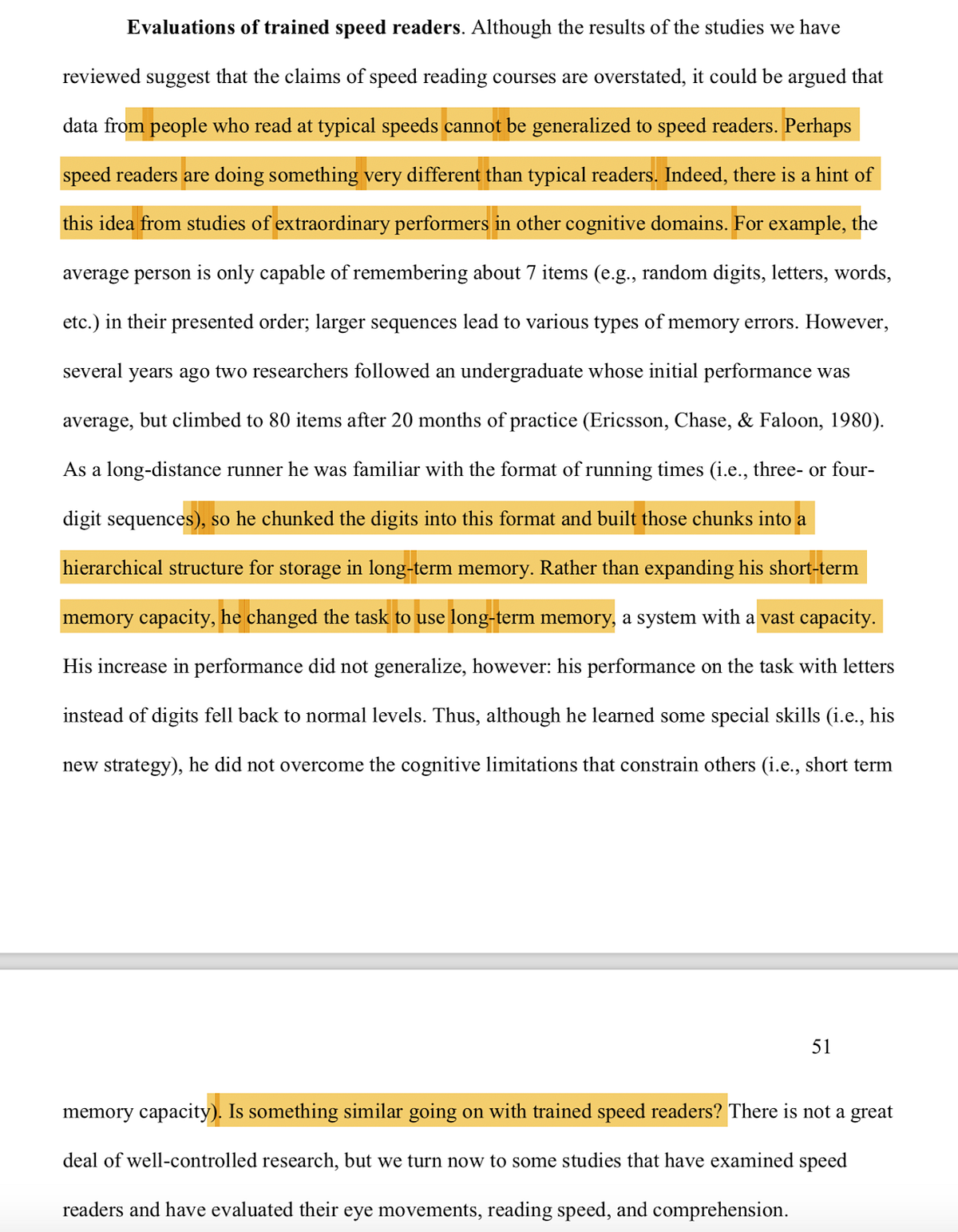
the authors have to admit that there are proven cases of speed reading — even if they’re overstated. The funny thing is, their defense is to claim that these people aren’t doing what other people are doing… they give the example of someone who did “impossible” memory techniques of numbers using chunking and memory techniques to lean on long term memory instead of short term memory, and then defend their stance by saying “is something similar going on with trained speed readers?
NO $#!*!!!
That’s exactly what we are advocating that you do!!!… To use memory techniques to overcome traditional limitations and push information into your long term memory, instead of reading slowly and using your short term memory.
My god, it’s like they’re handing the marketing firepower to me on a silver platter, you guys.
The example they give to debunk speed reading is a 1983 study where graduates of speed reading programs were given less than 6 minutes to speed read a college-level textbook…. A speed of 15,000 words per minute? And then say that even though the students were allowed to read the book 3 times, their comprehension was very bad.
Are you frickin’ kidding me?
Of course they couldn’t read that fast!
How about some studies with realistic claims, like 600–700 words per minute?
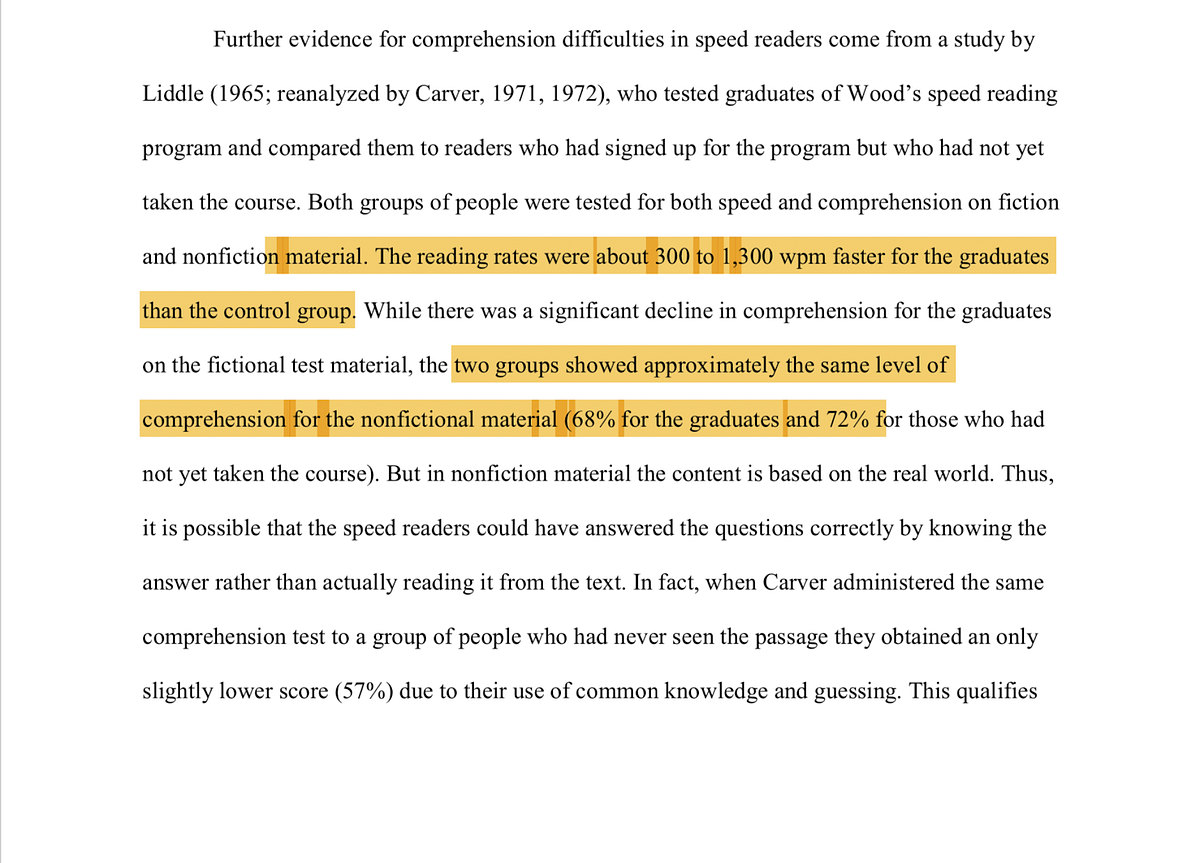
On page 52,
they are forced admit that graduates of a speed reading program read at 300–1300 words per minute FASTER than the control group, with the same level of comprehension on non-fictional materials. And this is for the Evelyn Wood program, which, personally, I had very little success with due to it’s lacking in visual memory techniques.
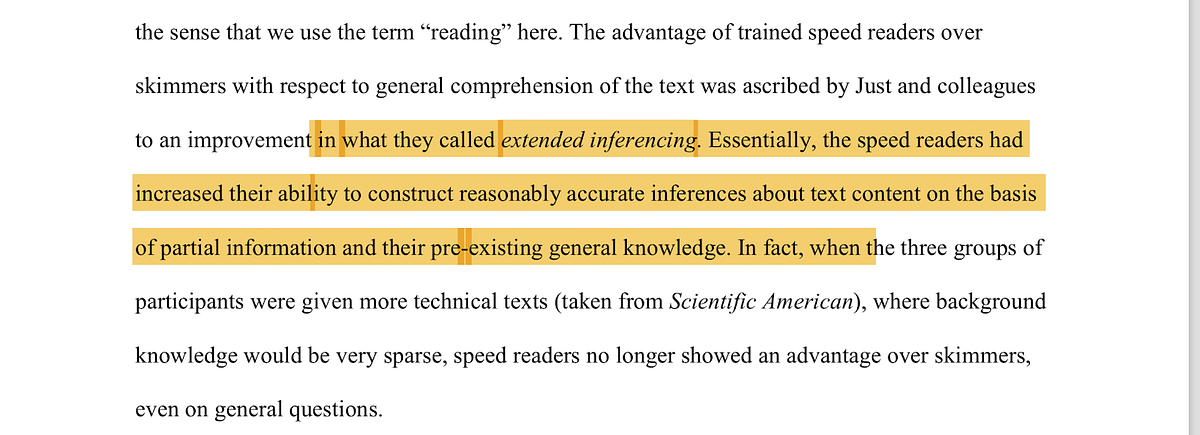
On page 53,
they give another example and show that speed readers were able to comprehend more than skimmers, but claim that it’s only because they were able to connect to pre-existing knowledge and infer logical connections. Now, I don’t know what kind of memory techniques and visualization those speed readers did besides connecting to pre-existing knowledge, but I would say… uh… yeah, that’s the whole point. Connecting to pre-existing knowledge and fact-checking your own assumptions about the text is one of the strategies we teach. That’s part of the reason why it works!
The list goes on:
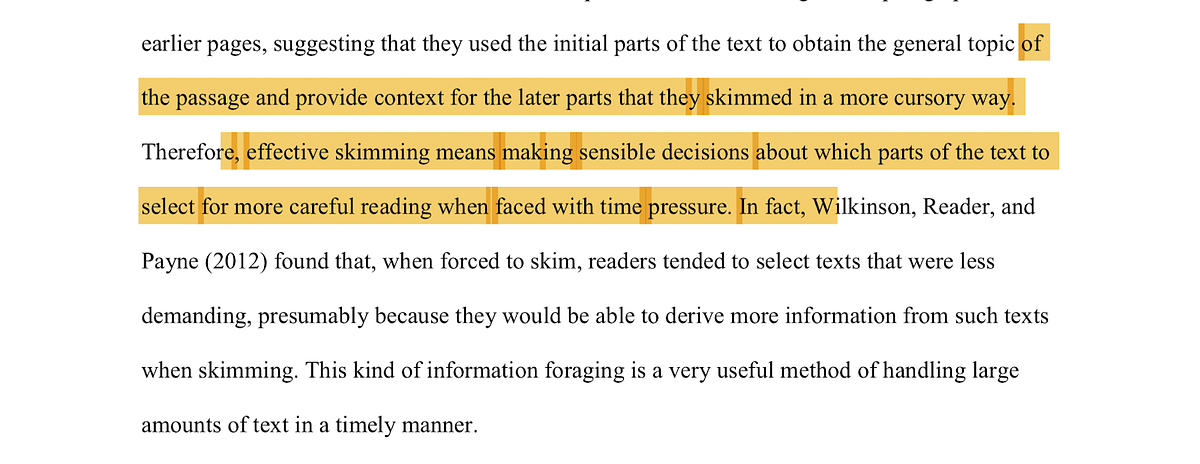
On page 55–56
they validate skimming — which is basically what we teach as pre-reading — saying that doing it will help you better summarize and understand the text. We’ve been saying that all along.
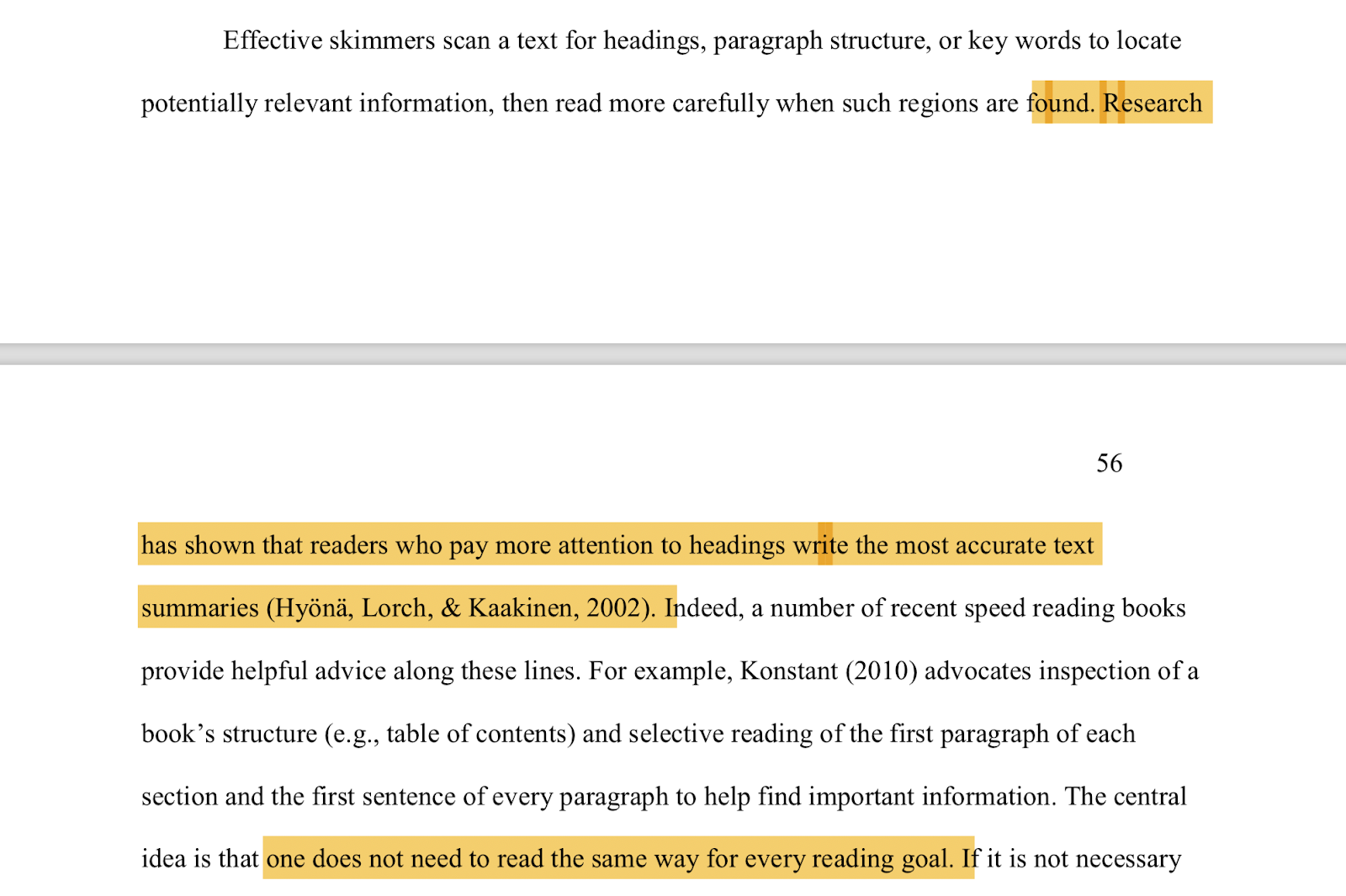
They go on to say that skimming
helps readers perform better under time pressure and make sensible decisions about what to focus on — no kidding! We’ve been teaching that — under the name of pre-reading — since day 1!
They actually say that skimming is an important skill — but fail to realize that if it’s used as pre-reading, it can alleviate a lot of the problems they came to discover with speed reading — in other words, the two are not mutually exclusive!
This video is already running long, guys, and so I’m not going to dive into the remainder of the report, which deals with speed-reading software. After all, because of the reasons I already mentioned above — I’m against these types of apps, and can only agree with the authors that they’re just not the same as actual reading with a page…
So, how about we look at some research that does support speed reading?
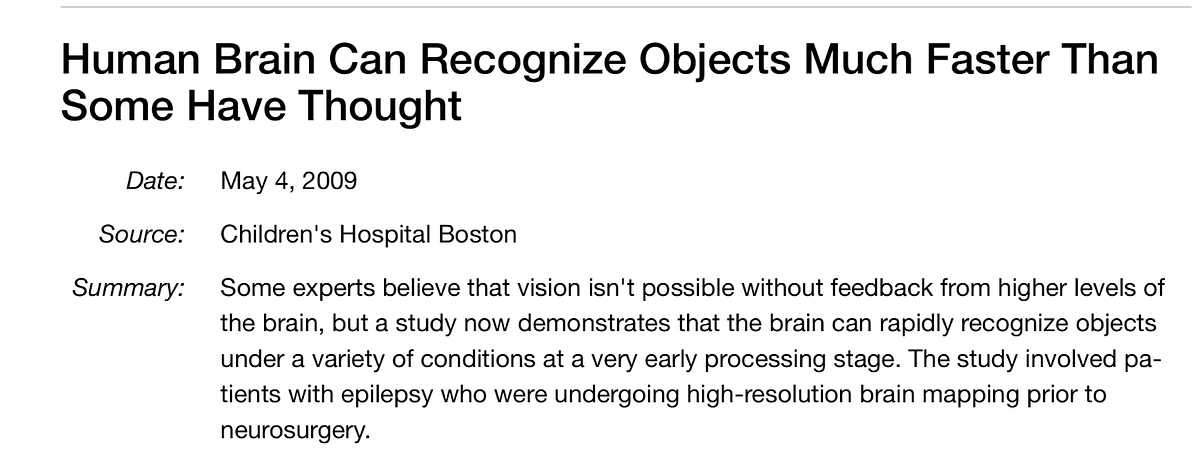
Well, to cite one, A study done at the children’s hospital in Boston in 2009 discovered that our brains are able to process images MUCH faster than we previously anticipated — as in — 100 milliseconds.
In the study, children were shown images from one of 5 categories,
and scientists measured to see which part of their brains lit up — meaning that they could instantly measure when the image was recognized and comprehended.
What’s really interesting is that this was the first study to plant electrodes
directly into the brain, as opposed to noninvasive monitors — which allowed scientists to avoid the lag of other measurement technologies, and be more exact in where they picked up activity.
They’re now exploring this further with movies — which, of course, are much more complex images than simple words — but the findings are very promising and exciting.
Now, here’s the funny thing. As I said, in our courses, we make claims very modest claims of 600–750 words per minute — despite the fact that my mentor — a gifted genius — reads much faster.
If you do the math, you’ll realize that 600 words per minute equals 10 words per second… which equals 1 word every… you guessed it… 100 milliseconds.
Now, figure in the added speed benefits of reading — or at least previewing — 2 to 3 words per minute like we discussed before, plus optimizing movements of the eye, and improving your speed by reducing — but not eliminating — subvocalization, and it’s quite easy to see how we substantiate our 600 word per minute claim.
But look, guys. I’ll be honest here.
Speed reading is a controversial topic, and the research isn’t all positive and favorable. While studies do seem to leave the door open for more modest claims of improved reading speed with minimal — if any loss of comprehension, the fact of the matter is, there have been a lot of dishonest and greedy people that have come along and made ridiculous and downright impossible claims over the last 70 years. Claims about photo-reading, absorbing entire pages in a glance, and 5,000 word per minute guarantees.
But I do think it’s important that we differentiate the types of reasonable and realistic speed reading — substantiated by research on how quickly our brains process images, and how effectively they are able to pick up information via peripheral vision and visual information process — from unrealistic hogwash.
Can a rare few people like Anne Jones and my mentor, Dr. Lev Goldentouch achieve speeds of 2 to 5 thousand words per minute? Yeah, maybe.
Should the average person hope to achieve speeds like that with high comprehension? Absolutely not.
But that doesn’t mean that you can’t significantly improve your reading speed and comprehension by taking advantage of the exact effects discussed by researchers — the parafoveal preview effect, and the incredibly fast speed with which your brain can process images.
In this post, I’ve tried to substantiate some of the claims that it is possible to read up to 600 or even 750 words per minute — 2 to 3 times faster than the average reader — with limited effects on comprehension.
But that doesn’t mean it’s easy, and it certainly doesn’t happen in some sketchy 1-day course at your local community college.
In our programs, it takes students literally months of training their eyes, their memories and their reading skills to achieve these results. And even then, speed reading at this level is physically and mentally exhausting, and it never comes naturally. Much like walking on your hands, you can get very good at, and do it for short bursts — but it’s always going to be easier and more comfortable to walk on your feet.
What I want to say is this:
Speed reading is a powerful and important skill in today’s information-overloaded society, but it’s just one small part of becoming a better learner. More important than the speed with which you read is whether or not you have the ability to understand, encode, retain, and apply large amounts of information effortlessly and effectively.
And that’s why, despite “speed reading” being a very sexy and alluring marketing opportunity, we design our programs to be 70+% focused on memory skills, learning habits, and health optimizations. Speed reading is, in our opinion, the “cherry on top” in many ways.
Because what’s the point of reading fast if you’re just going to forget everything you read?
What’s the point of trying to learn faster if your brain isn’t performing at it’s optimal capacity?
And why struggle through learning when a few changes to your habits and mindset can dramatically improve your experience and your results?
That, my friends, is how you really become a more effective learner.
So… in conclusion… Is Speed Reading a Hoax?
It depends on what kind of “speed reading” you’re talking about. But one way or another, it isn’t the magic bullet solution to all of your learning problems.
But hey, don’t take my word for it — after all, speed reading has already changed my life, and it’s my career. Admittedly, it’s nearly impossible for me to be objective on the topic. So I encourage you to read the research papers that I’ve speed-read and summarized here today, and come to your own conclusion as to whether or not my arguments make sense. If they do, then I hope you’ll give speed reading — and, of course, the accelerated learning techniques that make it truly possible — a try.
-JL

HealthIQ is a new type of life insurance company that uses science and data to give lower rates to health-conscious people like runners, weightlifters, and vegetarians. To see if you qualify today, visit http://www.HealthIQ.com/superhuman

This episode is brought to you by Organifi. Save 20% on their highly-recommended green juice products with coupon code “superhuman.”
In this episode, we discuss:
- The controversial topic of speed reading [3:40]
- A major study against speed reading [4:40]
- The main inconsistency in the paper disproving speed reading [6:00]
- Analysis of eye focus capabilities, as quoted in the study [6:30]
- The controversial argument in the study that created the inconsistency [8:50]
- The issue of comprehension at the speed of speed reading [11:20]
- Perception of the text vs the exact identification of the words [13:30]
- The maximum span of words we can comprehend with one eye fixation [15:30]
- Sub-vocalization can be reduced [17:30]
- The connection between memory techniques and speed reading [18:30]
- Skimming (or pre-reading as we call it) validated by the paper [20:30]
- The speed of image comprehension [22:00]
- How it all adds up to what we claim and teach [23:30]
- Speed reading is indeed a controversial topic [24:20]
- Improving your memory is more important than reading fast [27:00]
- Concluding, is speed reading a hoax? [28:00]
Resources Mentioned in This Episode:
- ‘So Much to Read, So Little Time: How Do We Read, and Can Speed Reading Help?' by Keith Rayner, Elizabeth R. Schotter, Michael E. J. Masson, Mary C. Potter, Rebecca Treiman
- Human Brain Can Recognize Objects Much Faster Than Some Have Thought by Boston Children's Hospital

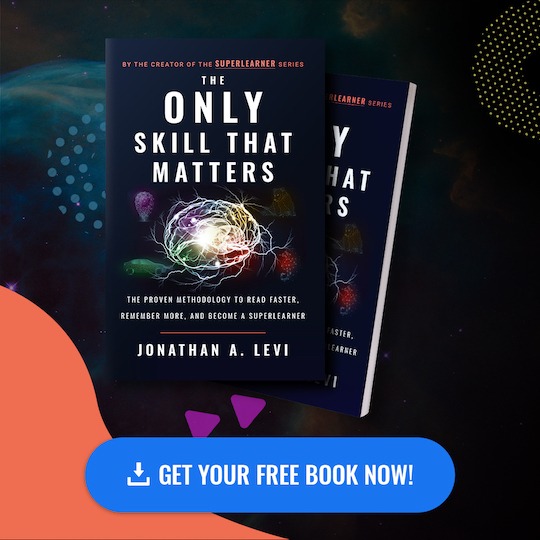




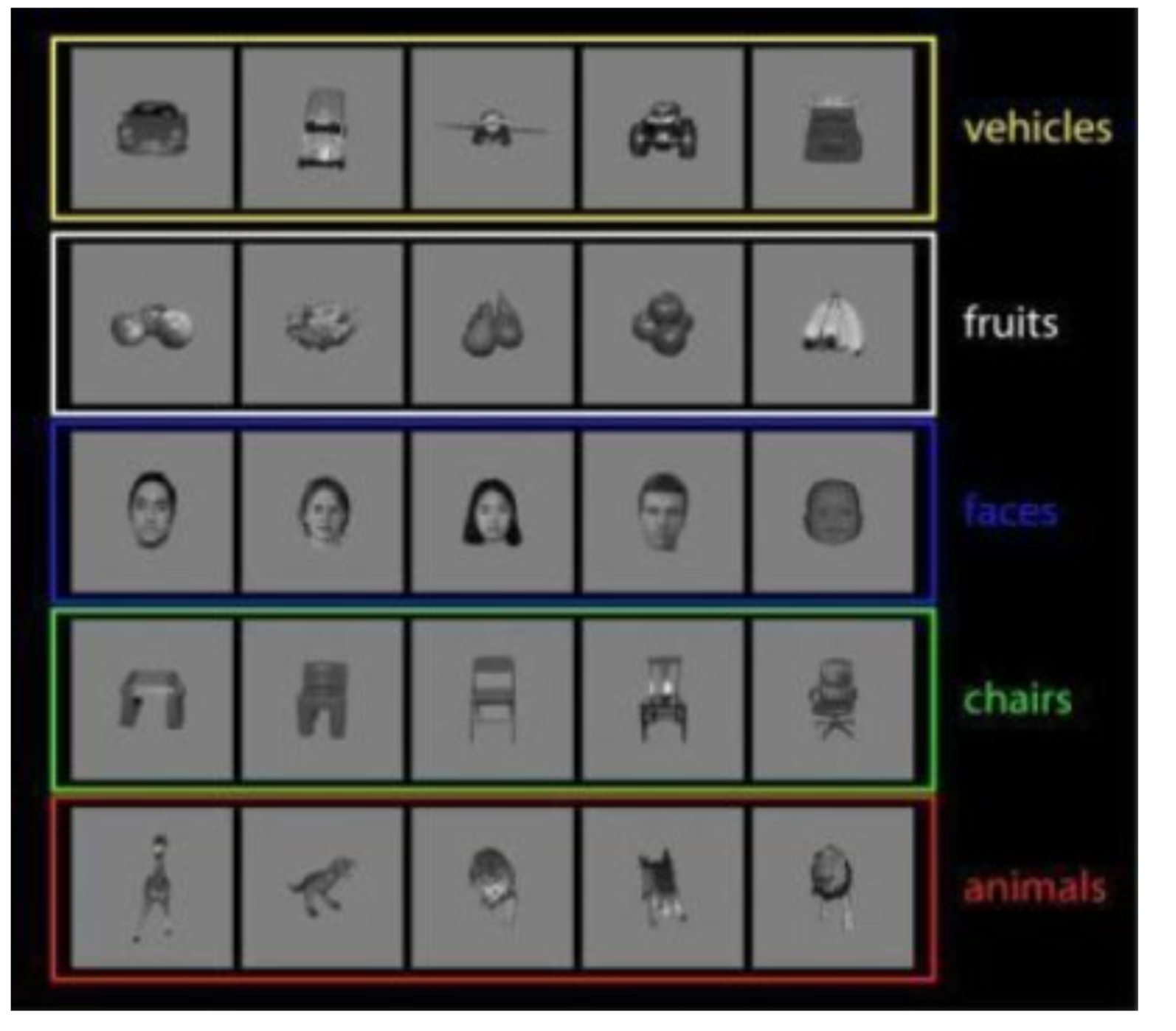
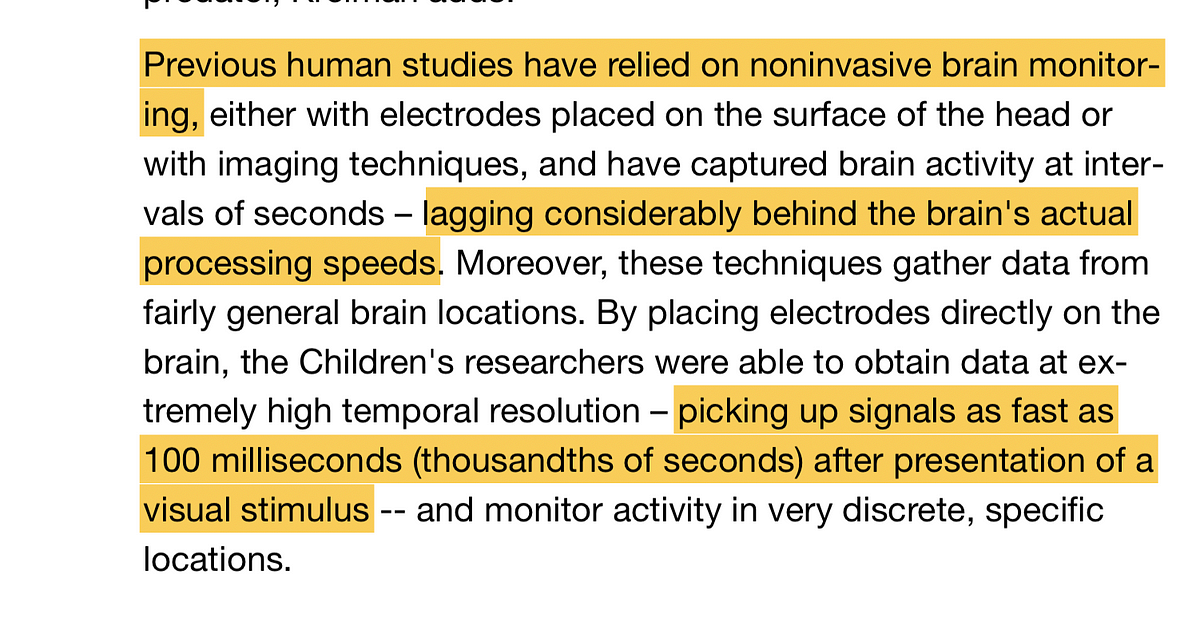










4 Comments
Thanks, I learned a lot of interesting things in past episodes.
loved th heart and the depth of the conversation. The way that Dr. Metivier shared from his enormous experience and insights was just amazing. Thank you Jonathan for doing this podcast!! 🙂
Great interview with Dr. Greg Wells! He mentioned a doctor from Colorado around the 42:30 point of the podcast, discussing turmeric and black pepper. I couldn’t make out the doctor’s name. Can you provide me with his full name and maybe his website or contact info. Interested in his products.
Thanks,
Rob
I am new here, and learning really fast.
Thank you.